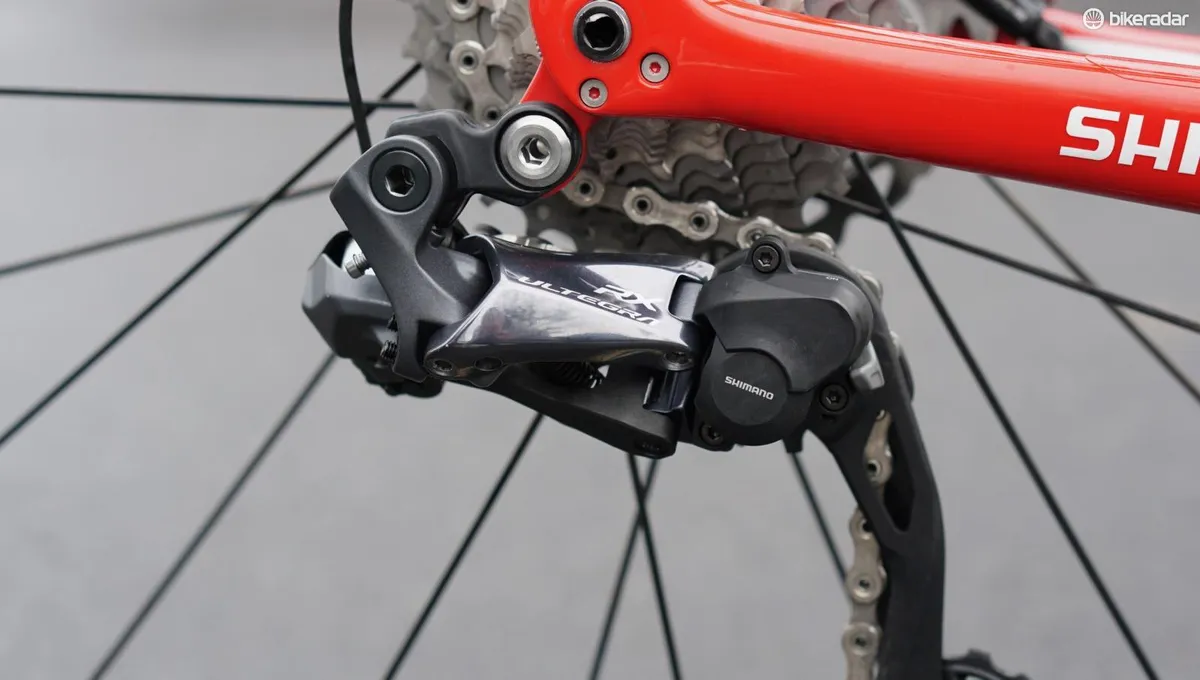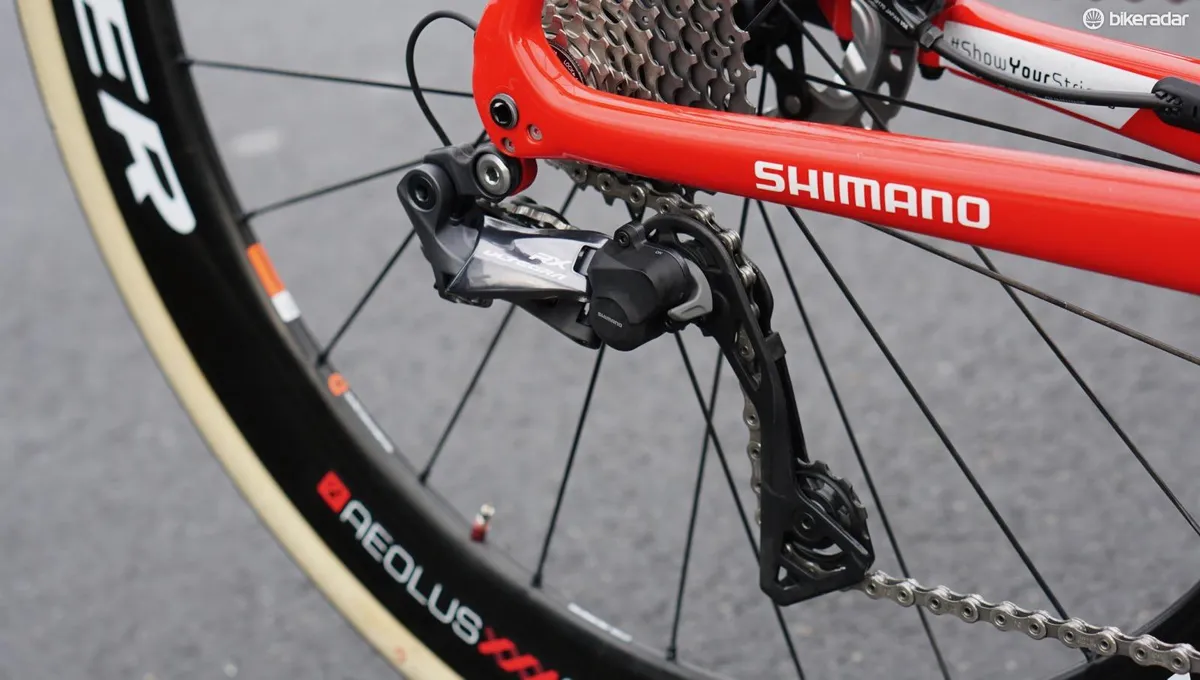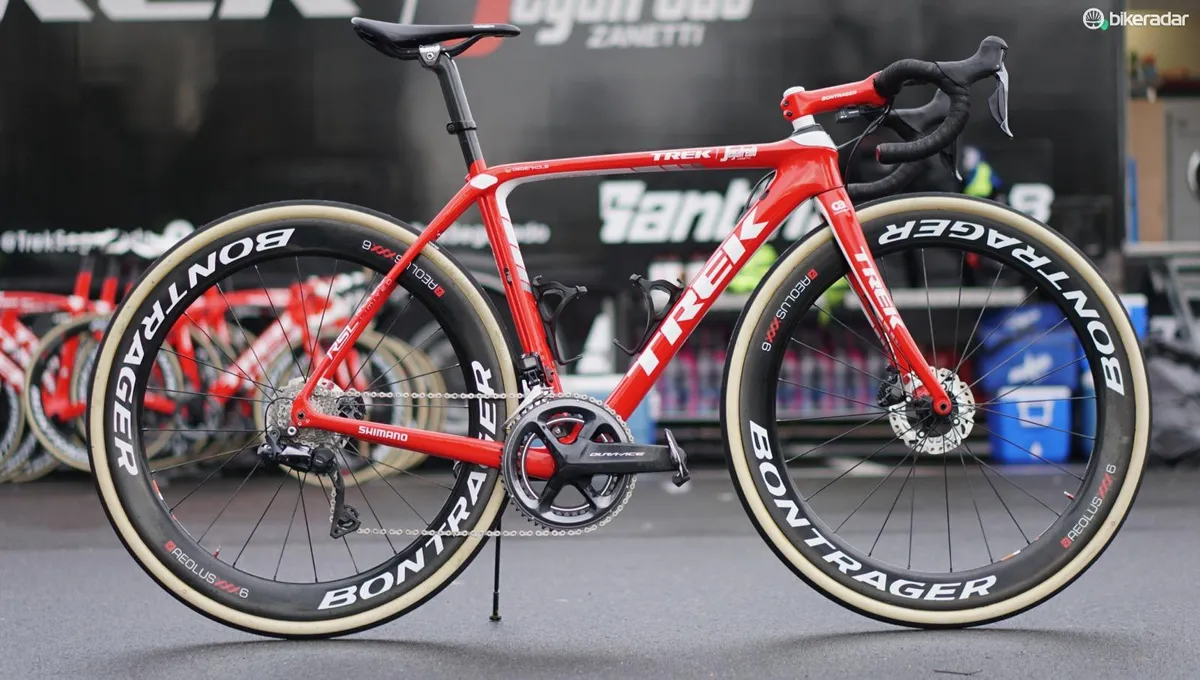We’ve already spotted Shimano’s clutch-equipped Ultegra RX derailleur on the cobbled roads of Flanders. Now, Shimano is releasing the complete details of this addition to Shimano’s Ultegra line.
Update: we now have a full review of the Ultegra RX Di2 derailleur.
- Tour of Flanders: huge tech gallery from De Ronde
- How to adjust a Shimano Shadow Plus clutch rear derailleur
Shimano Ultegra RX highlights
- Shadow Plus clutch mechanism reduces unwanted chain movement
- Available in mechanical and Di2 versions
- Compatible with all Shimano 11-speed road groups
- Maximum cassette range 11-34t
- Maximum chainring capacity 16t
What is a clutch and how does it work?
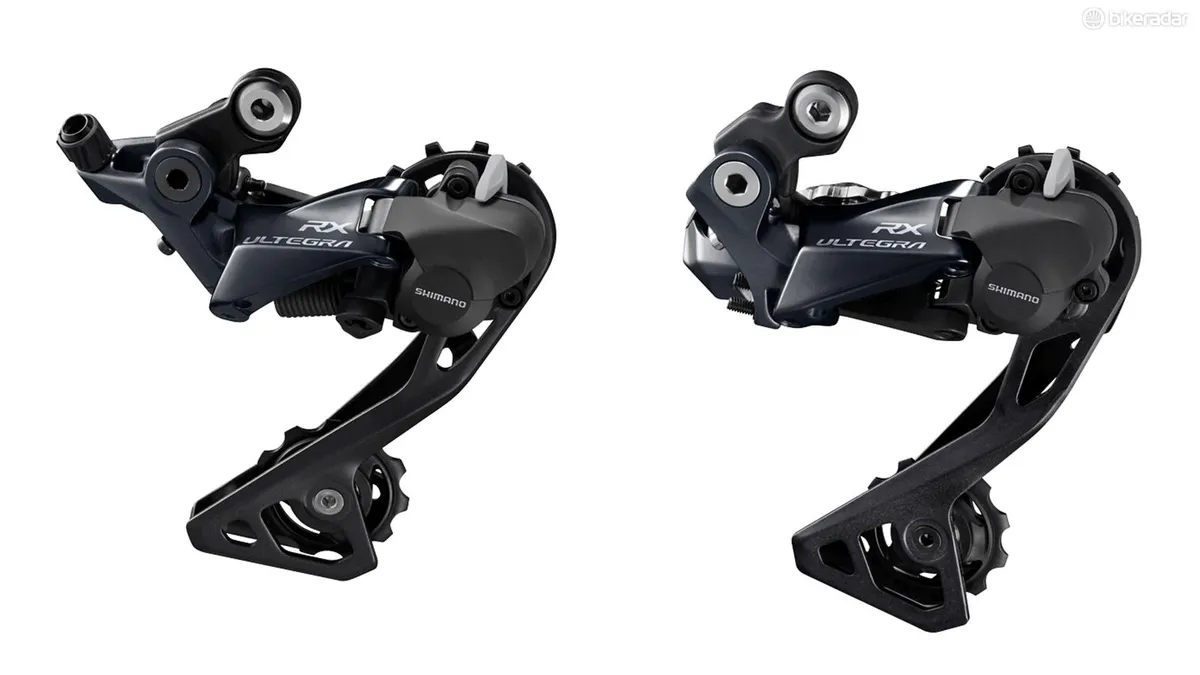
Shimano introduced the Shadow Plus system on mountain bike rear derailleurs in 2011. It is designed to reduce chain slap and improve chain retention and shift accuracy when riding over uneven surfaces.
Shimano has adapted this technology to meet the needs of cyclocross and gravel riders, as well as professional racers taking on the spring Classics, where a dropped chain can ruin a race.
'Shadow Plus' refers to the use of a one-way clutch that's built into the rear derailleur. Unlike SRAM, Shimano offers an on/off switch to engage or disengage the clutch mechanism.
When the lever is flipped to the ‘on’ position, a cam tightens a steel friction band around the derailleur’s main pivot. This keeps the chain taut by reducing unwanted movement of the derailleur cage when riding over rough terrain — be it rocks and roots on singletrack, or cobbled or gravel roads.
Mountain bikers generally leave the clutch in 'on' position and only turn it off to ease the installation and removal of the wheel from the frame. It’s very likely that we’ll see more use of the on/off switch on roads bikes as the clutch does add a small but measurable amount of friction.
Shimano Ultegra RX details
Shimano offers the RD-RX800 for mechanical drivetrains as well as the RX-805 version for Di2 systems.
Unlike SRAM’s clutch-equipped Force 1 and Rival 1 road rear derailleurs, which are designed exclusively for use with 1x drivetrains, the Ultegra RX rear derailleur can be used with two chainrings or a narrower-range 1x system.
This medium-cage road rear derailleur is compatible with all of Shimano’s 11-speed road drivetrains. It can be used with 11-28t cassettes up to the company’s wide-range 11-34t model.
In terms of chainring range, the maximum difference between large and small chainrings is 16t. This means Ultegra RX will work with most common chainring combinations, including 53/39, 52/36, 46/36, and the 48/32t sub-compact system that is becoming increasingly common on gravel bikes.
Shimano Ultegra RX rear derailleur pricing and availability
The mechanical RD-RX800 rear derailleur will retail for $109.99. The Di2 RX-805 version will retail for $284.99. Both versions will be available this summer.
(UK and Australian pricing have yet to be confirmed.)
First spotted at Flanders
Shimano Ultegra RX Di2 clutch derailleur
The Tour of Flanders contains more than a dozen cobbled stretches, many on short but sharp climbs, or hellingen. Paris-Roubaix the following Sunday of course contains more numerous and more brutal pavé sections.
Fat tubulars are the primary change teams make for these races — typically 26–28mm for Flanders and 28–30mm for Roubaix — but chain retention is also a concern as racers rattle across the stones. Most race bikes have chain catchers as a matter of course, to keep the chain from dropping off to the inside of the small chainring.

Trek-Segafredo technical director Matt Shriver said he had been asking Shimano for a road clutch derailleur for two years, even inquiring about hacking an XTR derailleur to work with the team's Dura-Ace Di2 drivetrains.
"More and more races are going to have some real technical stages, like a Roubaix, or even in the Tour they are going to have a mini Roubaix. So having an option to remove some of that chain movement is a good thing," Shriver said.
"Going on feedback from riders in the past, they don’t have problems with their drivetrain per se, but sometimes the tension will drop for a split second on really rough sections. There is maybe a small penalty in efficiency [with a clutch derailleur], but in a race like Flanders or Roubaix, you are losing a lot more when your drivetrain isn’t engaging smoothly because of chainslap."
Friction Facts founder Jason Smith has said clutch derailleurs — referencing SRAM's Force 1 derailleur at the time — do add a bit of resistance to the drivetrain.
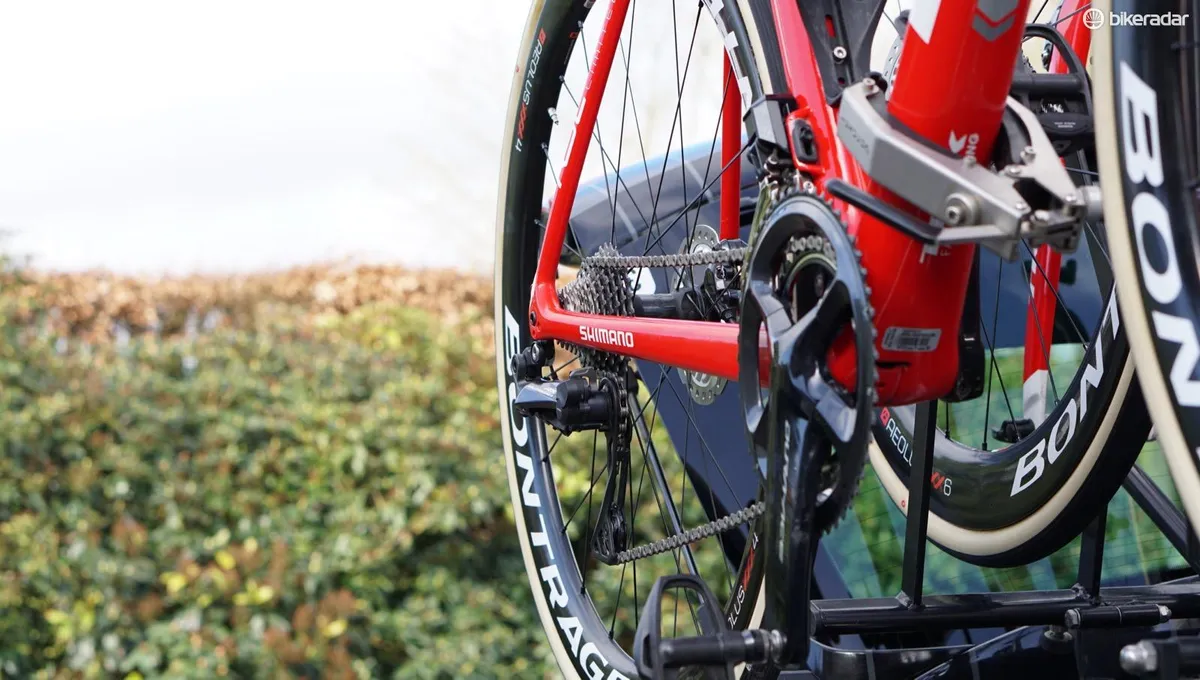
Speaking of Force 1, SRAM certainly got a sizable jump on Shimano with a road clutch derailleur, rolling out its Force 1 group for cyclocross in early 2014, and quickly moving that into road applications with bike-brand partners. The notable difference, of course, is that Shimano's Ultegra RX derailleur works with two chainrings, whereas SRAM's system is for a single chainring only.
In both cases, though, the concept is the same: reduce unwanted chain movement.
Shriver said that Trek did a lot of slow-speed camera work in development of its Domane endurance bike, and that it was "incredible to see how much the chain and the tires are moving over the cobbles."
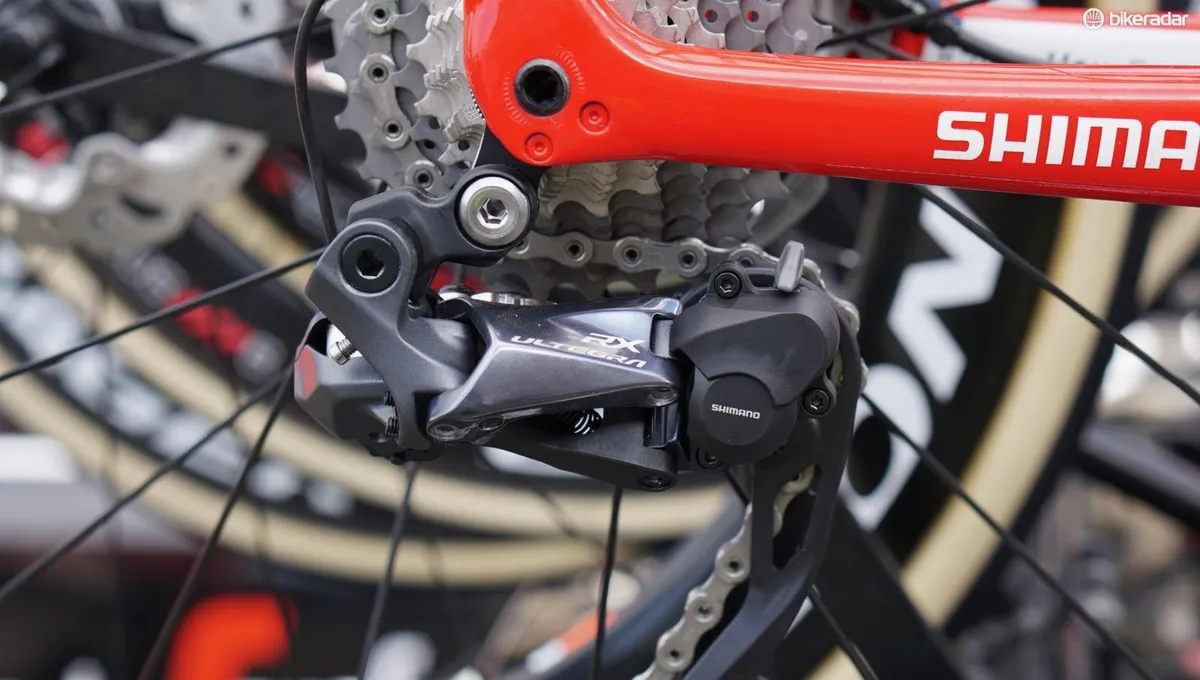
BikeRadar followed Trek-Segafredo on its Tour of Flanders recon ride, where 2015 Paris-Roubaix winner John Degenkolb was testing the Di2 version of the Ultegra RX clutch derailleur on his Domane disc bike for this year's Roubaix. (Watch the video above to see Degenkolb riding it on the cobbled Muur in recon.)
Degenkolb said he was happy with how it worked in keeping the chain tight. He spoke with Shimano technical staff about changing the derailleur from multi-shift (where holding down a lever causes the bike to shift a fixed number of gears) to just standard shifting.
In multi-shift mode, the bike still shifts normally, one gear at a time, with shorter presses. Only longer presses engage the multi-shift function.
Trek-Segafredo rider Koen de Kort told BikeRadar that he has already used the derailleur in Belgian races, and was also happy with how it worked.
